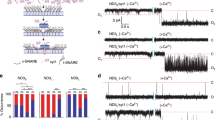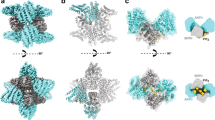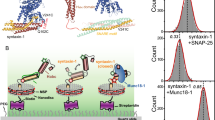Abstract
Understanding the fundamental role of soluble NSF attachment protein receptor (SNARE) complexes in membrane fusion requires knowledge of the spatiotemporal dynamics of their assembly. We visualized complexin (cplx), a cytosolic protein that binds assembled SNARE complexes, during single exocytic events in live cells. We found that cplx appeared briefly during full fusion. However, a truncated version of cplx containing only the SNARE-complex binding region persisted at fusion sites for seconds and caused fusion to be transient. Resealing pores with the mutant cplx only partially released transmitter and lipid probes, indicating that the pores are narrow and not purely lipidic in structure. Depletion of cplx similarly caused secretory cargo to be retained. These data suggest that cplx is recruited at a late step in exocytosis and modulates fusion pores composed of SNARE complexes.
This is a preview of subscription content, access via your institution
Access options
Subscribe to this journal
Receive 12 print issues and online access
$209.00 per year
only $17.42 per issue
Buy this article
- Purchase on Springer Link
- Instant access to full article PDF
Prices may be subject to local taxes which are calculated during checkout







Similar content being viewed by others
References
Jahn, R. & Scheller, R.H. SNAREs—engines for membrane fusion. Nat. Rev. Mol. Cell Biol. 7, 631–643 (2006).
Weber, T. et al. SNAREpins: minimal machinery for membrane fusion. Cell 92, 759–772 (1998).
Han, X., Wang, C.T., Bai, J., Chapman, E.R. & Jackson, M.B. Transmembrane segments of syntaxin line the fusion pore of Ca2+-triggered exocytosis. Science 304, 289–292 (2004).
Kesavan, J., Borisovska, M. & Bruns, D. v-SNARE actions during Ca2+-triggered exocytosis. Cell 131, 351–363 (2007).
Jackson, M.B. & Chapman, E.R. Fusion pores and fusion machines in Ca2+-triggered exocytosis. Annu. Rev. Biophys. Biomol. Struct. 35, 135–160 (2006).
Ungermann, C., Sato, K. & Wickner, W. Defining the functions of trans-SNARE pairs. Nature 396, 543–548 (1998).
Peters, C. et al. Trans-complex formation by proteolipid channels in the terminal phase of membrane fusion. Nature 409, 581–588 (2001).
Merrifield, C.J., Feldman, M.E., Wan, L. & Almers, W. Imaging actin and dynamin recruitment during invagination of single clathrin-coated pits. Nat. Cell Biol. 4, 691–698 (2002).
McMahon, H.T., Missler, M., Li, C. & Südhof, T.C. Complexins: cytosolic proteins that regulate SNAP receptor function. Cell 83, 111–119 (1995).
Chen, X. et al. Three-dimensional structure of the complexin/SNARE complex. Neuron 33, 397–409 (2002).
Bracher, A., Kadlec, J., Betz, H. & Weissenhorn, W. X-ray structure of a neuronal complexin-SNARE complex from squid. J. Biol. Chem. 277, 26517–26523 (2002).
Weninger, K., Bowen, M.E., Choi, U.B., Chu, S. & Brunger, A.T. Accessory proteins stabilize the acceptor complex for synaptobrevin, the 1:1 syntaxin/SNAP-25 complex. Structure 16, 308–320 (2008).
Guan, R., Dai, H. & Rizo, J. Binding of the Munc13-1 MUN domain to membrane-anchored SNARE complexes. Biochemistry 47, 1474–1481 (2008).
Yoon, T.Y. et al. Complexin and Ca2+ stimulate SNARE-mediated membrane fusion. Nat. Struct. Mol. Biol. 15, 707–713 (2008).
Giraudo, C.G., Eng, W.S., Melia, T.J. & Rothman, J.E. A clamping mechanism involved in SNARE-dependent exocytosis. Science 313, 676–680 (2006).
Tang, J. et al. A complexin/synaptotagmin 1 switch controls fast synaptic vesicle exocytosis. Cell 126, 1175–1187 (2006).
Xue, M. et al. Distinct domains of complexin I differentially regulate neurotransmitter release. Nat. Struct. Mol. Biol. 14, 949–958 (2007).
Cai, H. et al. Complexin II plays a positive role in Ca2+-triggered exocytosis by facilitating vesicle priming. Proc. Natl. Acad. Sci. USA 105, 19538–19543 (2008).
Taraska, J.W., Perrais, D., Ohara-Imaizumi, M., Nagamatsu, S. & Almers, W. Secretory granules are recaptured largely intact after stimulated exocytosis in cultured endocrine cells. Proc. Natl. Acad. Sci. USA 100, 2070–2075 (2003).
Pabst, S. et al. Selective interaction of complexin with the neuronal SNARE complex. Determination of the binding regions. J. Biol. Chem. 275, 19808–19818 (2000).
Miesenböck, G., De Angelis, D.A. & Rothman, J.E. Visualizing secretion and synaptic transmission with pH-sensitive green fluorescent proteins. Nature 394, 192–195 (1998).
Perrais, D., Kleppe, I.C., Taraska, J.W. & Almers, W. Recapture after exocytosis causes differential retention of protein in granules of bovine chromaffin cells. J. Physiol. (Lond.) 560, 413–428 (2004).
Ryan, T.A., Smith, S.J. & Reuter, H. The timing of synaptic vesicle endocytosis. Proc. Natl. Acad. Sci. USA 93, 5567–5571 (1996).
Pucadyil, T.J. & Chattopadhyay, A. Effect of cholesterol on lateral diffusion of fluorescent lipid probes in native hippocampal membranes. Chem. Phys. Lipids 143, 11–21 (2006).
Schmoranzer, J., Goulian, M., Axelrod, D. & Simon, S.M. Imaging constitutive exocytosis with total internal reflection fluorescence microscopy. J. Cell Biol. 149, 23–32 (2000).
Corcoran, J.J., Wilson, S.P. & Kirshner, N. Flux of catecholamines through chromaffin vesicles in cultured bovine adrenal medullary cells. J. Biol. Chem. 259, 6208–6214 (1984).
Fang, Q. et al. The role of the C terminus of the SNARE protein SNAP-25 in fusion pore opening and a model for fusion pore mechanics. Proc. Natl. Acad. Sci. USA 105, 15388–15392 (2008).
Bretou, M., Anne, C. & Darchen, F. A fast mode of membrane fusion dependent on tight SNARE zippering. J. Neurosci. 28, 8470–8476 (2008).
Wang, C.T. et al. Different domains of synaptotagmin control the choice between kiss-and-run and full fusion. Nature 424, 943–947 (2003).
Gong, L.W., de Toledo, G.A. & Lindau, M. Exocytotic catecholamine release is not associated with cation flux through channels in the vesicle membrane, but Na+ influx through the fusion pore. Nat. Cell Biol. 9, 915–922 (2007).
Reim, K. et al. Complexins regulate a late step in Ca2+-dependent neurotransmitter release. Cell 104, 71–81 (2001).
Chapman, E.R. Synaptotagmin: a Ca2+ sensor that triggers exocytosis? Nat. Rev. Mol. Cell Biol. 3, 498–508 (2002).
An, S. & Zenisek, D. Regulation of exocytosis in neurons and neuroendocrine cells. Curr. Opin. Neurobiol. 14, 522–530 (2004).
Taraska, J.W. & Almers, W. Bilayers merge even when exocytosis is transient. Proc. Natl. Acad. Sci. USA 101, 8780–8785 (2004).
Wu, Y., Yeh, F.L., Mao, F. & Chapman, E.R. Biophysical characterization of styryl dye-membrane interactions. Biophys. J. 97, 101–109 (2009).
Abderrahmani, A. et al. Complexin I regulates glucose-induced secretion in pancreatic beta-cells. J. Cell Sci. 117, 2239–2247 (2004).
Tadokoro, S., Nakanishi, M. & Hirashima, N. Complexin II facilitates exocytotic release in mast cells by enhancing Ca2+ sensitivity of the fusion process. J. Cell Sci. 118, 2239–2246 (2005).
Huntwork, S. & Littleton, J.T. A complexin fusion clamp regulates spontaneous neurotransmitter release and synaptic growth. Nat. Neurosci. 10, 1235–1237 (2007).
Xue, M. et al. Complexins facilitate neurotransmitter release at excitatory and inhibitory synapses in mammalian central nervous system. Proc. Natl. Acad. Sci. USA 105, 7875–7880 (2008).
Maximov, A., Tang, J., Yang, X., Pang, Z.P. & Südhof, T.C. Complexin controls the force transfer from SNARE complexes to membranes in fusion. Science 323, 516–521 (2009).
Itakura, M., Misawa, H., Sekiguchi, M., Takahashi, S. & Takahashi, M. Transfection analysis of functional roles of complexin I and II in the exocytosis of two different types of secretory vesicles. Biochem. Biophys. Res. Commun. 265, 691–696 (1999).
Archer, D.A., Graham, M.E. & Burgoyne, R.D. Complexin regulates the closure of the fusion pore during regulated vesicle exocytosis. J. Biol. Chem. 277, 18249–18252 (2002).
Schaub, J.R., Lu, X., Doneske, B., Shin, Y.K. & McNew, J.A. Hemifusion arrest by complexin is relieved by Ca2+-synaptotagmin I. Nat. Struct. Mol. Biol. 13, 748–750 (2006).
Giraudo, C.G. et al. Alternative zippering as an on-off switch for SNARE-mediated fusion. Science 323, 512–516 (2009).
Pabst, S. et al. Rapid and selective binding to the synaptic SNARE complex suggests a modulatory role of complexins in neuroexocytosis. J. Biol. Chem. 277, 7838–7848 (2002).
Li, Y., Augustine, G.J. & Weninger, K. Kinetics of complexin binding to the SNARE complex: correcting single molecule FRET measurements for hidden events. Biophys. J. 93, 2178–2187 (2007).
Edwardson, J.M. et al. Expression of mutant huntingtin blocks exocytosis in PC12 cells by depletion of complexin II. J. Biol. Chem. 278, 30849–30853 (2003).
An, S.J. & Almers, W. Tracking SNARE complex formation in live endocrine cells. Science 306, 1042–1046 (2004).
Axelrod, D., Koppel, D.E., Schlessinger, J., Elson, E. & Webb, W.W. Mobility measurement by analysis of fluorescence photobleaching recovery kinetics. Biophys. J. 16, 1055–1069 (1976).
Grabner, C.P., Price, S.D., Lysakowski, A. & Fox, A.P. Mouse chromaffin cells have two populations of dense core vesicles. J. Neurophysiol. 94, 2093–2104 (2005).
Acknowledgements
We thank F. Rivera-Molina and S. Viviano for technical assistance and P. De Camilli and D. Toomre for comments on the manuscript. This work was supported by McKnight and Kinship Foundations and US National Institutes of Health grants EY000785 and EY018111.
Author information
Authors and Affiliations
Contributions
S.J.A. designed, conducted and analyzed the research and wrote the manuscript. C.P.G. performed and analyzed the amperometry experiments. D.Z. supervised the project.
Corresponding author
Ethics declarations
Competing interests
The authors declare no competing financial interests.
Supplementary information
Supplementary Text and Figures
Supplementary Figures 1–16 (PDF 2804 kb)
Rights and permissions
About this article
Cite this article
An, S., Grabner, C. & Zenisek, D. Real-time visualization of complexin during single exocytic events. Nat Neurosci 13, 577–583 (2010). https://doi.org/10.1038/nn.2532
Received:
Accepted:
Published:
Issue Date:
DOI: https://doi.org/10.1038/nn.2532
This article is cited by
-
The complexin C-terminal amphipathic helix stabilizes the fusion pore open state by sculpting membranes
Nature Structural & Molecular Biology (2022)
-
Focused clamping of a single neuronal SNARE complex by complexin under high mechanical tension
Nature Communications (2018)
-
Should I stop or should I go? The role of complexin in neurotransmitter release
Nature Reviews Neuroscience (2016)
-
Complexins: small but capable
Cellular and Molecular Life Sciences (2015)



